b. Center for Integrative Conservation, Xishuangbanna Tropical Botanical Garden, Chinese Academy of Sciences, Menglun, Mengla, Yunnan, 666303, PR China;
c. Center of Conservation Biology, Core Botanical Gardens, Chinese Academy of Sciences, Menglun, Mengla, Yunnan, 666303, PR China;
d. School of Ecology and Environmental Science, Yunnan University, Kunming, Yunnan, 650091, PR China;
e. Forest Research Institute, Forest Department, Ministry of Environmental Conservation and Forestry, Yezin, Nay Pyi Taw, 05282, Myanmar
Myanmar is biologically extremely diverse and forms a major component of the Indo-Burma hotspot, which has been recognized both for its high value for biodiversity conservation and the high level of threats (Myers et al., 2000; Van Dijk et al., 2004). Thus far, ca. 11, 800 species in 273 families of spermatophyte have been reported from Myanmar (Kress et al., 2003), with the highest plant diversity in Kachin State, followed by the Tanintharyi Region (Table S1). The largest family in the Myanmar flora is Orchidaceae, and the largest genus is Rhododendron (Table S2 and S3). However, many more species are likely to exist and recent estimates of the total number of vascular plants (including ferns and lycophytes) was on the order of 16, 000 species (Middleton et al., 2019). Since British botanists, such as F. Kingdon-Ward, J. H. Lace, George Forrest, and F. G. Dickason, made botanical surveys over half a century ago, no comprehensive floristic surveys have been conducted in Myanmar and there are still many large areas with incomplete or non-existent botanical investigations (Tanaka, 2005; Ruchisansakun et al., 2018).
To understand and conserve the plant diversity of Myanmar, the Myanmar Forest Department has recently initiated botanical expeditions in collaboration with several international institutions, including the Southeast Asia Biodiversity Research Institute, Chinese Academy of Sciences (CAS-SEABRI), Smithsonian Institution, Makino Botanical Garden, New York Botanical Garden, Korean National Institute of Biological Resources, and National Museum of Nature and Science, Tokyo (Middleton et al., 2019). Many taxa new to science as well as many new records for Myanmar have been found (e.g. Jin et al., 2018; Kang et al., 2018; Ding et al., 2019a; Rodda et al., 2019; Tanaka et al., 2019b), and these botanical investigations have also contributed to taxonomic revisions (e.g. Ruchisansakun et al., 2018; Tanaka and Aung, 2019; Ding et al., 2019b; Yang et al., 2019; Maw et al., 2020), checklists (Tanaka et al., 2006; Khine et al., 2017; Hughes et al., 2019; Aung et al., 2020), and field guides (Fujikawa et al., 2008; Kang et al., 2017; Tanaka et al., 2019a). These publications include morphological descriptions and specimen locations, and form the basis for future large-scale syntheses, and for conservation risk assessment and strategy development (e.g., Khine and Schneider, 2020). However, recent taxonomic contributions and floristic works have yet to be comprehensively inventoried or reviewed.
In this study, we compiled a list of new and newly recorded plant taxa described in Myanmar from 2000 to 2019 based on an exhaustive survey of the literature. We hope this broad synthesis will both apprise botanists of recent taxonomic developments and provide the basis for future collections-based floristic research in Myanmar. Furthermore, we hope this work encourages young scientists to engage in the basic tasks of taxonomy, including field expeditions and herbarium work, in order that they may contribute to the preparation of a comprehensive Flora of Myanmar. We anticipate that the present study will also contribute to plant conservation in Myanmar.
2. Material and methods 2.1. Study areaMyanmar forms part of mainland Southeast Asia, bordering India and Bangladesh in the west, China to the north and northeast, and Laos and Thailand to the east (Fig. 1). The country occupies an area of 676, 577 km2 and extends from 09°28' to 28°29'N and 92°100' to 101°10'E (MOECAF, 2011). Many factors have contributed to Myanmar's exceptional floristic diversity (Kress et al., 2003; Kurzweil and Lwin, 2013; Ruchisansakun et al., 2018). Myanmar has a complex tectonic history and was assembled beginning in the late Cretaceous from widely separated components (Westerweel et al., 2019). This has resulted in extremely diverse geology and topography. The topography, in turn, interacts with the monsoons to produce a great diversity of climate types and thus vegetation types. The vegetation of Myanmar can be broadly categorized into six major types: tropical evergreen forest, mainly distributed in the southeast and southwest; subtropical evergreen forest, mainly distributed in the north and west; semi-evergreen and mixed deciduous forests, mainly distributed in the east and north; savanna, which occurs in central Myanmar; alpine vegetation, which occurs in the northeast; and mangrove forest (Davis, 1960; Tanaka, 2005; Kurzweil and Lwin, 2013).

|
| Fig. 1 Location and administrative divisions of Myanmar. |
The present inventory of new and newly recorded taxa in Myanmar is based on plant taxonomy publications from January 2000 to December 2019 . We started by searching the International Plant Names Index (IPNI, https://www.ipni.org/) for vascular plants distributed in Myanmar (and Burma) published after 1999 and before 2020 , removing names with invalid nomenclature, and combining our data with data from the World Checklist of Selected Plant Families (WCSP, http://www.kew.org/wcsp), a unique and continuously updated synonymized world list of plants (Paton et al., 2008), as a baseline for collection references.
Additional taxonomic articles were collected by using key word searches ("new species" or "new record" and "Myanmar" or "Burma" or "Southeast Asia") in the major academic online resources, including Web of Science, Google Scholar, ResearchGate, Sci-Hub and others. We also searched regional revisions of genera and families for information on Myanmar taxa. All duplicated records were deleted. We searched for articles in Chinese using the depository of China Knowledge Resource Integrated Database (www.cnki.net) and other Chinese online academic resources. Although we tried to make this study exhaustive, it is possible that we have overlooked publications that include new taxa from Myanmar, particularly from studies involving molecular sequence data.
Our inventory of new and newly recorded vascular plants from Myanmar includes records from more than 50 taxonomic and systematic journals, and other published monographs. Order and family names used here followed APG IV (Angiosperm Phylogeny Group, 2016) for angiosperms and PPG I (Pteridophyte Phylogeny Group, 2016) for ferns and lycophytes.
We extracted data on the distribution of each taxon at the state or region level from the type specimens or other specimen localities cited in the original published literature. Distribution data, however, were available for only 211 new and 354 newly recorded taxa, as the localities for some taxa were unclear. To analyze the conservation status of new taxa endemic to Myanmar, we also included initial conservation assessments for species according to IUCN criteria.
3. ResultsWe assembled a list that contains 580 new and newly recorded taxa (Appendixes 2 and 3) that have been described from Myanmar over the last two decades, altogether representing 91 families and 320 genera (Table 1). This list contains 13 new genera, 193 new species (Fig. 2 for some representatives), 7 new subspecies, 19 new varieties, and 2 new forms. This list also contains 3 newly recorded families, 34 newly recorded genera, 347 newly recorded species, 4 newly recorded subspecies, 7 newly recorded varieties, and 1 newly recorded form. The 13 new genera are Wuodendron B. Xue, Y. H. Tan & Chaowasku (Annonaceae) (Xue et al., 2018), Okia H. Rob. & Skvarla (Asteraceae) (Robinson and Skvarla, 2010), Khasianthus H. Rob. & Skvarla (Asteraceae) (Robinson and Skvarla, 2009), Pseudocodon D.Y. Hong & H. Sun (Campanulaceae) (Wang et al., 2014), Chrysojasminum Banfi (Oleaceae) (Banf, 2014), Sirindhornia H.A. Pedersen & Suksathan (Orchidaceae) (Pedersen et al., 2002), Benstonea Callm. & Buerki (Pandanaceae) (Callmander et al., 2012), Tzveleviochloa RÖser & A. WÖlk (Poaceae) (WÖolk and RÖoser, 2017), Veldkampia Ibaragi & Shiro Kobay. (Poaceae) (Ibaragi and Kobayashi, 2008), Debia Neupane & N. Wikstr. and Involucrella (Benth. & Hook. f.) Neupane & N. Wikstr. (Rubiaceae) (Neupane et al., 2015), Ridsdalea J.T. Pereira & K.M. Wong (Rubiaceae) (Wong and Pereira, 2016), and Larsenianthus W.J. Kress & Mood (Zingiberaceae) (Kress et al., 2015). Some of these new genera result from recent molecular studies that have changed the status of previously published species. The three newly recorded families are Petrosaviaceae (Jin and Mint, 2018), Triuridaceae (Jin et al., 2018), and Polyosmaceae (Ding et al., 2019a). The 34 newly recorded genera belong to 21 families (Fig. 3 and Appendix 1); twenty of the genera were published in 2019 (Fig. 6).
| Group | Families | Genera | Species | Infraspecific taxa | Total taxa |
| Ferns and Lycophytes | 9 | 14 | 21 | 0 | 21 |
| Gymnosperms | 2 | 3 | 2 | 1 | 3 |
| Angiosperms | 80 | 303 | 517 | 39 | 556 |
| Total | 91 | 320 | 540 | 40 | 580 |
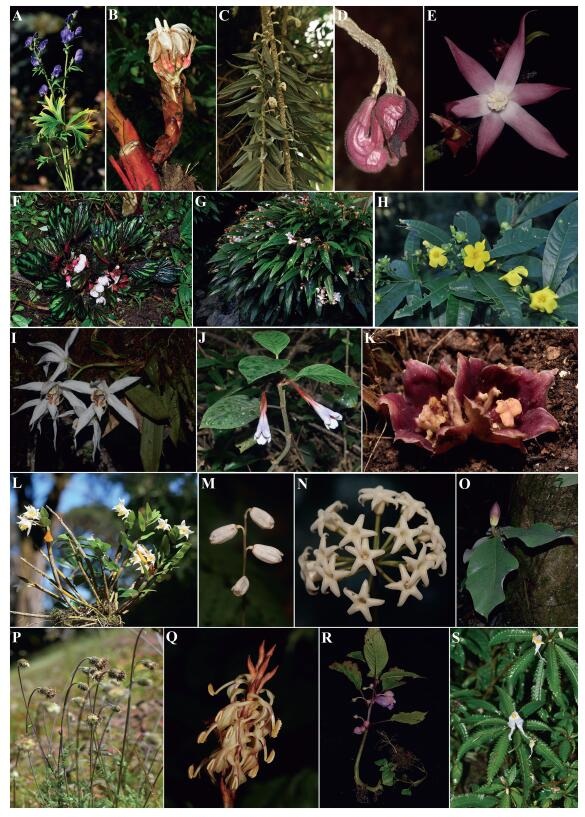
|
| Fig. 2 Some representative new species discovered in Myanmar. (A) Aconitum jin-muratae Kadota & Nb. Tanaka, 2010; (B) Amomum ampliflorum Y.H. Tan & H.B. Ding, 2019 ; (C)Agapetes brevipedicellata Y. H. Tan & S.S. Zhou, 2017 ; (D) Aristolochia sinoburmanica Y.H.Tan & B. Yang, 2018; (E) Trivalvaria rubra Y.H. Tan, S.S. Zhou & B. Yang, 2018; (F) Begonia kingdon-wardii Tebbitt, 2007 ; (G) Begonia rheophytica M. Hughes, 2019 ; (H) Reinwardtia glandulifera Y.H.Tan, S.S.Zhou & B. Yang, 2017 ; (I) Coelogyne magnifica Y.H. Tan, S.S. Zhou & B.Yang, 2017 ; (J) Acranthera burmanica Y. H. Tan & B. Yang, 2015; (K) Tupistra natmataungensis Y.H. Tan & H.B. Ding, 2019 ; (L) Dendrobium koyamae Nb. Tanaka, T Yukawa & J. Murata, 2010 ; (M) Gastrodia putaoensis X.H. Jin, 2017; (N) Hoya kachinensis Rodda & K. Armstrong, 2019 ; (O) Magnolia kachinensis S.S. Zhou, Q. Liu & Sima 2018 ; (P) Himalaiella natmataungensis K. Fujikawa, 2012 ; (Q) Hedychium putaoense Y.H. Tan & H.B. Ding, 2018 ; (R) Impatiens kingdon-wardii Nob. Tanaka & T. Sugaw, 2015 ; (S) Impatiens casseabriae Y.H.Tan, S.S.Zhou & B. Yang, 2017 . Photos: A, G, P, R by Bin Yang; B, D, E, K, L, M, N, Q by Hong-Bo Ding; C, F, H, J, S by Yun-Hong Tan; I by Xiang-Le Zeng; O by Shi-Shun Zhou. |

|
| Fig. 3 The number of new and newly recorded genera of vascular plants in Myanmar from 2000 to 2019 . |
Among the top 15 families (Fig. 4), those with the most new taxa described were Orchidaceae (30 taxa), Zingiberaceae (19 taxa), Lauraceae (12 taxa), Begoniaceae (11 taxa), Acanthaceae (11 taxa), and Balsaminaceae (10 taxa) (Fig. 4b), while the families with most new records were Orchidaceae (116 taxa), Zingiberaceae (24 taxa), Balsaminaceae (20 taxa), Cyperaceae (13 taxa), and Apocynaceae (12 taxa) (Fig. 4c). Orchidaceae, Zingiberaceae, and Balsaminaceae contributed most taxa to the combined list (Fig. 4a). Among the top 15 plant genera (Fig. 5), those with the most new and newly recorded taxa were Impatiens (30 taxa), Begonia (18 taxa), Zingiber (15 taxa), Hoya (12 taxa), Bulbophyllum (11 taxa), Habenaria (11taxa), Calanthe (10 taxa), and Strobilanthes (10 taxa).
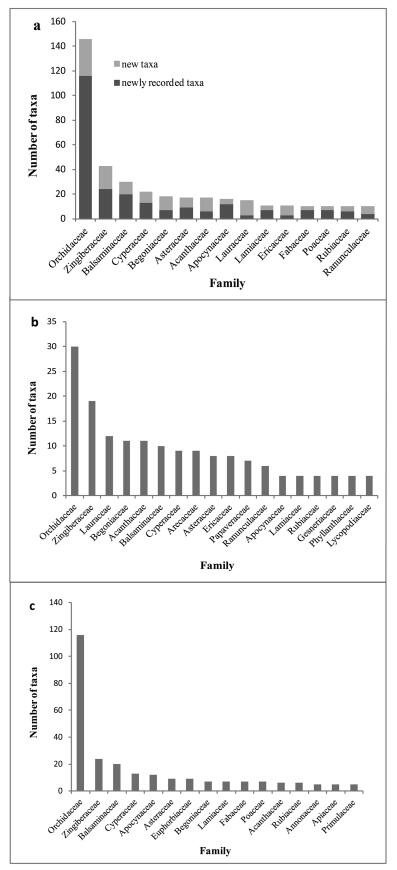
|
| Fig. 4 The top 15 plant families of new and newly recorded taxa (a. total taxa, b. newtaxa, c. newly recorded taxa) for the flora of Myanmar over the past 20 years(2000-2019). |
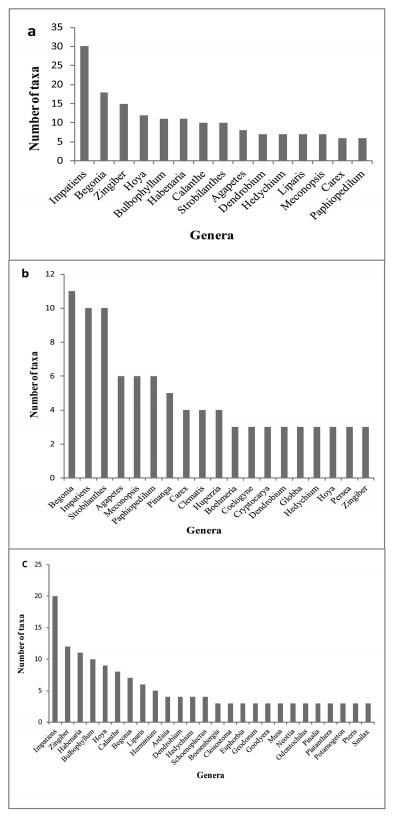
|
| Fig. 5 The top 15 plant genera of new and newly recorded taxa(a. total taxa, b. new taxa, c. newly recorded taxa) for the flora of Myanmar over the past 20 years(2000-2019). |
During the last two decades, the number of new and newly recorded taxa increased, although irregularly, with the highest numbers of both new (33) and newly recorded (102) taxa reported in 2018 (Fig. 6). The greatest numbers of new and newly recorded taxa were discovered in Kachin State, in northeast Myanmar, followed by Chin State in western Myanmar, the Mandalay region in central Myanmar, Shan State in eastern Myanmar, and the Tanintharyi Region in southernmost Myanmar (Fig. 7). Few new taxa or records were recorded from the Sagaing Region, in northwest Myanmar, or from most parts of southwestern and southern Myanmar.
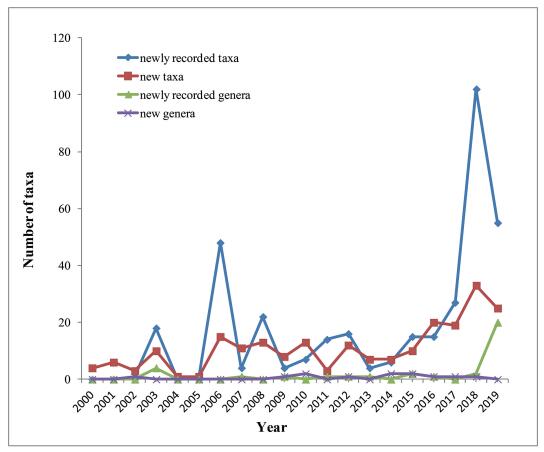
|
| Fig. 6 The number of new and newly recorded taxa for the flora of Myanmar. over the past 20 years (2000-2019 ). |
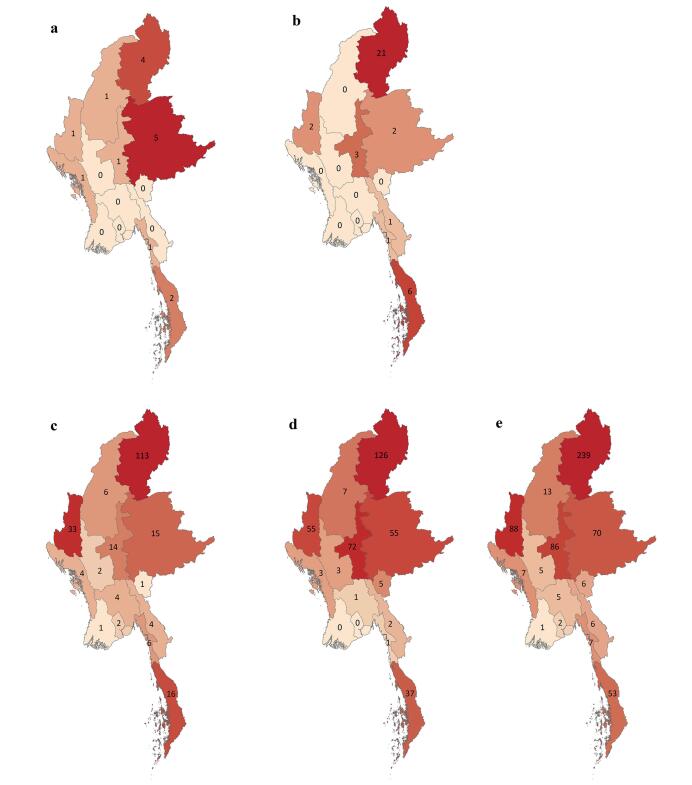
|
| Fig. 7 The distribution of new and newly recorded taxa (a. new genera, b. newly recorded genera, c. new taxa, d. newly recorded taxa, e. total taxa) for the flora of Myanmar over the past 20 years (2000-2019) |
Of the 221 new taxa, 157 are endemic to Myanmar. The regional assessment of IUCN conservation status of these new taxa revealed that 22 species are threatened (8 Critically Endangered, 5 Endangered, 9 Vulnerable), 3 Near Threatened, 15 Least Concerned, and 31 Data Deficient. An additional 150 species have not been evaluated. Kachin State had the highest number of both threatened and nonthreatened species, followed by Chin State.
4. DiscussionAlthough the increase in new and newly recorded taxa is encouraging, it also reflects the incompleteness of our current knowledge of the flora of Myanmar and the urgent need for a greatly expanded effort. Almost every botanical survey made in recent years in Myanmar has revealed undescribed species and new records. Moreover, compared with adjacent areas, the species discovery rate in Myanmar is low. From 2000 to 2017 , around 1400 new and newly recorded taxa were published from Yunnan province, southwestern China (Du and Ma, 2019a, 2019b). Between 2011 and 2017 , almost 3000 new species were described from Southeast Asia: 417 species from the Philippines, 116 species from Sumatra, 450 species from Thailand, 530 species from Vietnam, 465 species from New Guinea (Middleton et al., 2019), 231 new taxa from Laos, and nearly 350 new taxa from Northeast India (data retraced from IPNI). If the estimate of 16, 000 species in Myanmar (Middleton et al., 2019) is correct, then the 540 new or newly recorded species added in the last 20 years is only a small fraction of the ca. 4000 species that still await discovery.
In theory, we might expect that more new species and records would be found in megadiverse families with more species; however, except for the Orchidaceae, this has not been generally true in Myanmar, where few species have been added to the lists of large families such as the Fabaceae, Rubiaceae, and Euphorbiaceae. The attractive flowers of orchids have drawn many specialists to Myanmar (e.g., Kurzweil and Lwin, 2013; Jin and Kyaw, 2017; Kurzweil and Ormerod, 2018), where the family is very diverse (Aung et al., 2020). However, even for the Orchidaceae, an estimated 150e300 additional species still remain to be discovered (Aung et al., 2020). Conversely, generalist collectors tend to overlook species with inconspicuous flowers, such as the Poaceae, Cyperaceae, and Urticaceae, and may also avoid some families with big leaves, such as the Musaceae and Arecaceae, from which it is difficult to make specimens. In several other genera, such as Begonia, Impatiens, Zingiber, Calanthe, Strobilanthes, Hoya, and Agapetes (Fig. 5), recent taxonomic studies have contributed to progress on the flora of Myanmar (Wood and Scotland, 2009; Tong and Xia, 2014; Kurzweil and Ormerod, 2018, 2019; Ruchisansakun et al., 2018; Aung and Tanaka, 2019; Hughes et al., 2019; Maw et al., 2020; Rodda et al., 2019; Yang et al., 2019) and increased our understanding of the diversity of these genera in Myanmar. However, although temperate components (e.g., Rhododendron and Primula) and some tropical dominant genera (e.g., Ficus, Ixora, Syzygium, and Diospyros) in Myanmar are highly diverse, our knowledge of these components is relatively limited (Kress et al., 2003; Table S3). The completion of the flora thus requires that experts on all vascular plant families and genera contribute modern taxonomic treatments (Aung et al., 2020).
Most new and newly recorded taxa are from herbaceous families, which probably reflect the difficulty of collecting tree and liana species, particularly at remote sites without canopy access. Many woody taxa flower infrequently and it is not easy to find flowering material, as well as good fruiting specimens where these are important, as in the Fagaceae (Middleton et al., 2019) and Lauraceae. Even when fertile trees are located, they are often too tall to collect. Also, unlike herbaceous taxa, such as Orchidaceae, Gesneriaceae, Begonia and Impatiens, it is not practical to grow specimens in a greenhouse until they flower and fruit.
Most species discoveries and publications reported here have relied on recent collecting activities of international collaborators throughout Myanmar (Middleton et al., 2019). Except for Nat Ma Taung National Park (Chin State) and Popa Mountain Park (Mandalay Region), in western and central Myanmar respectively, where the transportation is relatively convenient for plant collection, most national parks lack even basic botanical inventories (Tanaka et al., 2006; Fujikawa et al., 2008; Kang et al., 2017). The southern and northern parts of Myanmar are in most need of collecting programs and botanical documentation. The northern states are particularly under-collected. Northern Myanmar still has vast areas covered by evergreen or semi-evergreen forests and also alpine vegetation, with steep terrain and poor infrastructure in remote regions making exploration difficult (Wahlsteen, 2019). Access to much of northern Myanmar has also been limited for political reasons, so state floras are lacking. Much of our current knowledge of the flora of this region comes from Francis Kingdon-Ward(1944, 1945), who made about 12 expeditions to northern Myanmar between 1919 and 1956 (Middleton et al., 2019).
The establishment of a Flora project in Myanmar will have a positive effect by stimulating collecting efforts and the active curation of existing collections, and by ensuring that the botanical infrastructure can support these activities (Middleton et al., 2019). Once the combined outputs are available online, collection data could then be used in a variety of projects or programs, such as producing specimen-based species checklists for protected areas, and eventually for a comprehensive Flora of Myanmar. We should recognize that no country can have experts in all taxa, so proactive international cooperation is indispensable (Costello et al., 2013). With the increasing international attention on research into the plant diversity of Myanmar in recent years, taxonomic studies on genera and families have facilitated the discovery of new species and new records (Kurzweil and Ormerod, 2018; Ruchisansakun et al., 2018; Tanaka and Aung, 2019; Ding et al., 2019b; Yang et al., 2019; Maw et al., 2020). However, there is still a long way to go before the floristic diversity of Myanmar can be fully understood.
The significance of new species discovery is that we can document them before they go extinct (Kennedy and Fjeldså, 2020). Identifying species and their distributions not only helps researchers further understand how ecological and evolutionary processes have generated the full diversity of vascular plants in Myanmar, but also helps policymakers establish conservation and economic priorities. At present, the conservation status of most vascular plant species new to science are assessed under the IUCN standard criteria. These preliminary assessments provide baseline data that government departments and funding agencies can use to propose conservation strategies, especially for those species with important economic value. We hope our preliminary findings will shed light on the conservation of plant diversity in Myanmar. Currently, the threat level for the 157 endemic new taxa in Myanmar is underestimated due to the data gaps, and 80% of new taxa are designated as either Data Deficient (DD; 25 taxa) or Not Evaluated (NE; 102 taxa). Due to limited field survey results, most new taxa have only been found in the type localities and with small populations, especially for those species endemic to Myanmar; thus, further investigation is needed to accurately assess their conservation status. Rare species and species with small geographic ranges are expected to be particularly susceptible to environmental changes and human impacts, and to have a higher risk of extinction (Khine and Schneider, 2020). Myanmar has a high rate of annual forest loss (Bhagwat et al., 2017), ranking as the highest in Southeast Asia and the third highest in the world (FAO, 2005). Furthermore, according to the authors' personal observations (Fig. 8), there is no denying the fact that population growth (Ministry of Immigration and Population, 2015), human activities, such as road construction (e.g., Tong and Xia, 2014; Yang et al., 2018), slash-and burn agriculture (e.g., Aung and Jin, 2018), firewood extraction, and illegal timber logging, have led to habitat destruction and deforestation in northern and western parts of Myanmar (e.g., Liu et al., 2018; Tan et al., 2018; Zhou et al., 2018). Therefore, plant conservation efforts in Myanmar should be formulated that balance utilization required for national development with protection.
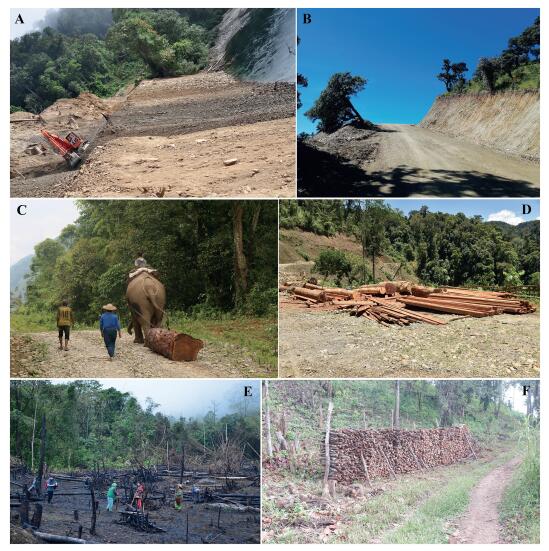
|
| Fig. 8 Deforestation and destructive activities caused by the livelihoods and development of Northern and Western Myanmar. (A-B) Road construction; (C-D) illegal timber logging; (E) destruction from slash-and-burn cultivation; (F) firewood cutting. Photos: A by Yun-Hong Tan; B, D by Bin Yang; C by Hong-Bo Ding, E by Shi-Shun Zhou; F by Qi-Qing Zhang. |
Y-HT, BY and RTC planned and designed the research. BY, AZW, H-BD, MBM and PPW collected the data, M-XZ analysed the data and made the distribution map, BY analysed the data and wrote the manuscript, Y-HT, RTC, MD revised the manuscript.
Declaration of competing interestThe author declares no conflict of interest.
AcknowledgementsWe are grateful to the many Myanmar colleagues who are staff at the Forest Institute of Myanmar and have helped us in carrying out field work in Myanmar. We also thank Dr. Kazumi Fujikawa (Makino Botanical Garden, Japan), Dr. Tapas Chakrabarty (Indian Museum, Botanical Survey of India), Dr. Paul Ormerod (Australia), Dr. Qiang Liu (Yunnan Forestry Technological College, China), Dr. Xiao-Hua Jin (Institute of Botany, CAS), Ms. Chong-Rui Ai, Dr. Phyo Kay Khine, Dr. Guo-Gang Li, Dr. Ravi Kant Chaturvedi (Xishuangbanna Tropical Botanical Garden, CAS), Ms. Ning Du (Kunming Institute of Botany, CAS), Mr. Shuai Liao (East China Normal University, China), Dr. Khoon Meng Wong (Singapore Botanic Gardens, Singapore), and Mr. Bin-Jie Ge (Shanghai Chenshan Botanical Garden, China), who sent us some useful literature, and Mr. Chen Du and Dr. Jin-Shuang Ma (Shanghai Chenshan Botanical Garden, China), Dr. Rui-Chang Quan (Xishuangbanna Tropical Botanical Garden, CAS), and Dr. Jian-Wen Zhang (Kunming Institute of Botany, CAS) for critical and constructive suggestions, Mr. Shi-shun Zhou, and Ms. Qi-Qing Zhang (Xishuangbanna Tropical Botanical Garden, CAS) for providing some photos. This research was supported by National Natural Science Foundation of China (No.31900180 and 31970223) and the Southeast Asia Biodiversity Research Institute, Chinese Academy of Sciences (Grant No. Y4ZK111B01).
Appendix A. Supplementary dataSupplementary data to this article can be found online at https://doi.org/10.1016/j.pld.2020.06.005.
Angiosperm Phylogeny Group, 2016. An update of the angiosperm phylogeny group classification for the orders and families of flowering plants: APG IV. Bot. J. Linn.Soc, 181(1): 1-20. DOI:10.1111/boj.12385 |
Aung Y.L., Mu A.T., Aung M.H., et al, 2020. An annotated checklist of Myanmar orchid flora. In: Jin X.H., Xia N.H., Tan, Y.H. (Eds.), Plant Diversity of Southeast Asia-ò, vol, 138: pp. 49-112. |
Aung M.M., Tanaka N., 2019. Seven taxa of Zingiber (Zingiberaceae) newly recorded for the flora of Myanmar. Bull. Natl. Mus. Nat. Sci., Ser. B, 45(1): 1-8. |
Aung Y.L., Jin X.H., 2018. Gastrodia kachinensis (Orchidaceae) a new species from Myanmar. In: Jin, X.H., Shui Y.M., Tan Y.H., et al. (Eds.), Plant Diversity in Southeast Asia, vol, 94: pp. 23-29. |
Banf E., 2014. Chrysojasminum, a new genus for Jasminum sect. Alternifolia (Oleaceae, Jasmineae). NHS Natural History Sciences Atti della Società italiana di Scienze Naturali e del Museo Civico di Storia Naturale in Milano, 1: 3-6. DOI:10.4081/nhs.2014.54 |
Bhagwat T., Hess A., Horning N., et al, 2017. Losing a jeweldrapid declines in Myanmaros intact forests from 2002-2014. PloS One 12: e0176364. DOI:10.1371/journal.pone.0176364 |
Callmander M.W., Lowry ò P.P., Forest F., et al, 2012. Benstonea Callm. & Buerki(Pandanaceae): characterization, circumscription, and distribution of a new genus of screwpines, with a synopsis of accepted species. Candollea, 67: 323-345. DOI:10.15553/c2012v672a12 |
Costello M.J., May R.M., Stork N.E., 2013. Can we name Earth's species before they go extinct?. Science, 1126: 413-416. DOI:10.1126/science.1230318 |
Davis J.H., 1960. The Forests of Burma. University of Mandalay, University of Florida. |
Ding H.B., Yang B., Zhou S.S., et al, 2019a. New contributions to the flora of Myanmar I. Plant Diversity, 41(3): 135-152. DOI:10.1016/j.pld.2019.05.002 |
Ding H.B., Zhou S.S., Yang B., et al, 2019b. Taxonomic studies on Amomum Roxburgh s.l. (Zingiberaceae) in Myanmar I:two new species and two new records for the flora of Myanmar. Phytotaxa, 418(2): 158-170. DOI:10.11646/phytotaxa.418.2.2 |
Du, C., Ma, J.S., 2019a. Chinese Plant Names Index 2000-2009. Science press, Beijing, pp. 1-606.
|
Du C., Ma J.S., 2019b. Chinese Plant Names Index 2010-2017. Science press, Beijing, pp: pp. 1-603. |
F AO, 2005. Global Forest Resources Assessment. UN Food and Agriculture Organization, Rome. |
Fujikawa K., Kuroiwa N., Maeda A., et al, 2008. 100 Wild Flowers of Natma Taung. The Kochi Prefectural Makino Botanical Garden, Kochi: pp. 1-75. |
Hughes M., Aung M.M., Armstrong K., 2019. An updated checklist and a new species of Begonia (B.rheophytica) from Myanmar. Edinb. J. Bot, 76(2): 285-295. DOI:10.1017/S0960428619000052 |
Ibaragi Y., Kobayashi S., 2008. Veldkampia (gramineae), a new genus from Myanmar. J. Jpn. Bot, 83: 106-112. |
Jin X.H., Kyaw M., 2017. Gastrodia putaoensis sp.nov. (Orchidaceae epidendroideae) from north Myanmar. Nord. J. Bot., Le, 35: 730-732. DOI:10.1111/njb.01581 |
Jin X.H., Mint Z., 2018. Petrosaviaceae, a new familial record of angiosperm from Myanmar. J. Trop. Subtropical Bot, 26(6): 677-678. DOI:10.11926/jtsb.3897 |
Jin X.H., Zhu X.Y., Mint Z., 2018. Triuridaceae, a new familial record of angiosperm from Myanmar. J. Trop. Subtropical Bot, 26(1): 79-81. DOI:10.11926/jtsb.3778 |
Kang D.H., Kyaw N.O., Jung E.K., et al, 2018. New records of flowering plants for the flora of Myanmar collected from southern Shan State. Korean J. Plant Taxon, 48(3): 218-229. DOI:10.11110/kjpt.2018.48.3.218 |
Kang, D.H., Lee, J.H., Ong, H.G., et al., 2017. Seed Plants of Natma Taung National Park, Myanmar. National Institute of Biological Resources (NIBR), Incheon, pp. 1-632.
|
Kennedy J.D., Fjeldså J., 2020. Completing Wallace's journey. Science, 367(6467): 140-141. DOI:10.1126/science.aba3798 |
Khine P.K., Fraser-Jenkins C., Lindsay S., et al, 2017. A contribution toward the knowledge of ferns and lycophytes from northern and northwestern Myanmar. Am. Fern J, 107(4): 219-256. DOI:10.1640/0002-8444-107.4.219 |
Khine P.K., Schneider H., 2020. First assessment of pteridophytes' composition and conservation status in Myanmar. Glob. Ecol. Conserv, 22. DOI:10.1016/j.gecco.2020.e00995 |
Kingdon-Ward F., 1944. A sketch of the botany and geography of North Burma (Part I). J. Bombay Nat. Hist. Soc, 44: 550-574. |
Kingdon-Ward F., 1945. A sketch of the botany and geography of North Burma (Part ò, Part ó). J. Bombay Nat. Hist. Soc, 45: 16-30, 133-148. |
Kress W.J., DeFilipps R.A., Farr E., et al, 2003. A checklist of the trees, shrubs, herbs, and climbers of Myanmar (revised from the original works by JH Lace, R.., Rodger, HG Hundley and U Chit Ko Ko on the pList of trees, shrubs, herbs and principal climbers etc. recorded from Burmaq). Contrib. U. S. Natl. Herb, 45: 1-590. |
Rodger, HG Hundley and U Chit Ko Ko on the "List of trees, shrubs, herbs and principal climbers etc. recorded from Burma"). Contrib. U. S. Natl. Herb. 45, 1-590.
|
Kress W.J., Mood J.D., Sabu M., et al, 2015. Larsenianthus, a new Asian genus of Gingers (Zingiberaceae) with four species. PhytoKeys 1: 15-32. DOI:10.3897/phytokeys.1.658 |
Kurzweil H., Lwin S., 2013. A Guide to Orchids of Myanmar. Natural History Publications (Borneo), Sabah, Malaysia, pp: 1-196. |
Kurzweil H., Ormerod P., 2018. Precursory studies on the orchid flora of Myanmar with one new species and thirty eight new distribution records. Rheedea, 28(1): 1-15. DOI:10.22244/rheedea.2018.28.1.01 |
Kurzweil H., Ormerod P., 2019. A review of the Calanthe group (Orchidaceae) in Myanmar. Thai For. Bull. (Bot.), 47(2): 196-225. DOI:10.20531/tfb.2019.47.2.12 |
Liu Q., Zhou S.S., Jin X.H., et al, 2018. Dendrobium naungmungense (Orchidaceae dendrobieae), a new species from Kachin state, Myanmar. In: Jin, X.H., Shui Y.M., Tan Y.H., Kang, M. (Eds.), Plant Diversity in Southeast Asia, vol94.PhytoKeys, pp: pp. 31-38. |
Maw, M.B., Ding, H.B., Yang, B., et al., 2020. Taxonomic studies on Begonia (Begoniaceae) in Myanmar I: three new species and supplementary description of Begonia rheophytica from Northern Myanmar. In: Jin, X.H., Xia, N.H., Tan, Y.H.(Eds.), Plant Diversity of Southeast Asia-Ⅱ, vol. 138. PhytoKeys, pp. 203-217.
|
Middleton D.J., Armstrong K., Baba Y., et al, 2019. Progress on Southeast Asiaos flora projects. Gard. Bull. Singa, 71(2): 267-319. DOI:10.26492/gbs71(2).2019-02 |
Ministry of Immigration and Population, 2015. The 2014 Myanmar Population and Housing Census: the Union Report.
|
MOECAF (Ministry of Environmental Conservation and Forestry), 2011. National biodiversity strategy and action plan Myanmar [Internet], pp. 1-121. http://www.cbd.int/doc/world/mm/mm-nbsap-01-en.pdf. (Accessed 31 December 2019).
|
Myers N., Mittermeier R.A., Mittermeier C.G., et al, 2000. Biodiversity hotspots for conservation priorities. Nature, 403: 853-858. DOI:10.1038/35002501 |
Neupane S., Dessein S., Wikstr#246;m N., et al, 2015. The hedyotis-Oldenlandia complex (Rubiaceae: spermacoceae) in Asia and the pacific: phylogeny revisited with new generic delimitations. Taxon, 64(2): 299-322. DOI:10.12705/642.8 |
Paton A.J., Brummitt N., Govaerts R., et al, 2008. Towards target 1 of the global strategy for plant conservation: a working list of all known plant specieseprogress and prospects. Taxon, 57: 602-611. |
Pedersen H.#198;.Suksathan P., Indhamusika S., 2002. Sirindhornia, a new orchid genus from Southeast Asia. Nord. J. Bot, 22(4): 391-404. DOI:10.1111/j.1756-1051.2002.tb01390.x |
Pteridophyte Phylogeny Group, 2016. A community-derived classification for extant lycophytes and ferns. J. Systemat. Evol, 54: 563-603. DOI:10.1111/jse.12229 |
Robinson H., Skvarla J.J., 2009. A new genus, Khasianthus, from India, Myanmar, and China. Proc. Biol. Soc. Wash, 122(2): 146-149. DOI:10.2988/08-20.1 |
Robinson H., Skvarla J.J., 2010. A new genus, Okia, from northern Myanmar (Vernonieae, Asteraceae). Proc. Biol. Soc. Wash, 123(1): 87-91. DOI:10.2988/09-26.1 |
Rodda M., Aung M.M., Armstrong K., 2019. A new species, a new subspecies, and new records of Hoya (Apocynaceae, Asclepiadoideae) from Myanmar and China. Brittonia, 71(4): 424-434. DOI:10.1007/s12228-019-09575-y |
Ruchisansakun S., Suksathan P., van der Niet T., et al, 2018. Balsaminaceae of Myanmar. Blume, 63: 199-267. DOI:10.3767/blumea.2018.63.03.01 |
Tan, Y.H., Li, D.R., Zhou, S.S., et al., 2018. Premna grandipaniculata (Lamiaceae, Premnoideae), a remarkable new species from north Myanmar. In: Jin, X.H., Shui, Y.M., Tan, Y.H., Kang, M. (Eds.), Plant Diversity in Southeast Asia, vol. 94.PhytoKeys, pp. 117-123.
|
Tanaka N., 2005. Plant inventory research: contributions to the flora of Myanmar. Acta Phytotaxonomica Geobot, 56(1): 21-26. |
Tanaka N., Aung M.M., 2019. Taxonomic studies on Zingiberaceae of Myanmar I: a new species of curcuma (subgenus ecomatae) from Myanmar. Phytotaxa, 387(3): 241-248. DOI:10.11646/phytotaxa.387.3.4 |
Tanaka N., Ito Y., Aung M.M., et al, 2019a. A Field Guide to Aquatic Plants of Myanmar. Natural History Publications (Borneo), Sabah, Malaysia, pp: 1-112. |
Tanaka N., Koyama T., Murata J., 2006. The flowering plants of Mt; Popa, Central Myanmar; Results of Myanmar-Japanese joint expeditions 2000-2004.. Makinoa, n.s, 5: 1-102. |
Tanaka N., Nagamasu H., Tagane S., et al, 2019b. Contributions to the Flora of Myanmar IV: a new species and a newly recorded taxon of the genus Sapria(Rafflesiaceae). Taiwania, 64(4): 357-362. DOI:10.6165/tai.2019.64.357 |
Tong Y.H., Xia N.H., 2014. New taxa of Agapetes (ericaceae) from Myanmar. Phytotaxa, 184(1): 39-45. DOI:10.11646/phytotaxa.184.1.5 |
Van Dijk P.P., Tordoff A.W., Fellowes J., et al, 2004. Indo-Burma. In:Mittermeier C.G., Lamoreaux J., da Fonseca, G.A.B. (Eds.), Hotspots Revisited:Earthos Biologically Richest and Most Endangered Terrestrial Ecoregions. CEMEX, Agrupación Sierra Madre, Mexico, pp: pp. 323-330. |
Wahlsteen E., 2019. A new species of Begonia L. (Begoniaceae) and some notes on Begonia difformis from Kachin, northern Myanmar. Phytotaxa, 420(3): 241-248. DOI:10.11646/phytotaxa.420.3.4 |
Wang Q., Ma X.T., Hong D.Y., 2014. Phylogenetic analyses reveal three new genera of the Campanulaceae. J. Systemat. Evol, 52(5): 541-550. DOI:10.1111/jse.12096 |
Westerweel J., Roperch P., Lichet A., et al, 2019. Burma Terrane part of the TransTethyan arc during collision with India according to palaeomagnetic data. Nat.Geosci, 12: 863-868. DOI:10.1038/s41561-019-0443-2 |
W#246;lk A.Röser M., 2017. Hybridization and long-distance colonization in oat-like grasses of South and East Asia, including an amended circumscription of Helictotrichon and the description of the new genus Tzveleviochloa (Poaceae). Taxon, 66(1): 20-43. DOI:10.12705/661.2 |
Wong K.M., Pereira J.T., 2016. A taxonomic treatment of the Asiatic allies of Rothmannia(Rubiaceae: gardenieae), including the new genera Ridsdalea and Singaporandia. Sandakania, 21: 21-64. |
Wood J.R.I., Scotland R.W., 2009. New and little-known species of Strobilanthes(Acanthaceae) from India and south east Asia. Kew Bull, 64(1): 3-47. DOI:10.1007/s12225-009-9098-2 |
Xue B., Tan Y.H., Thomas D.C., et al, 2018. A new Annonaceae genus, Wuodendron, provides support for a post-boreotropical origin of the Asian-Neotropical disjunction in the tribe Miliuseae. Taxon, 67(2): 250-266. DOI:10.12705/672.2 |
Yang B., Ding H.B., Zhou S.S., et al, 2018. Aristolochia sinoburmanica (Aristolochiaceae) a new species from north Myanmar. In: Jin, X.H., Shui Y.M., Tan Y.H., Kang, M. (Eds.), Plant Diversity in Southeast Asia, vol, 94. PhytoKeys, pp: pp. 13-22. |
Yang B., Ding H.B., Zhou S.S., et al, 2019. Taxonomic studies on Agapetes in Myanmar I:Agapetes reflexiloba, a new species from Kachin State, and notes on three rediscovered species including two new records for Myanmar. Phytotaxa, 393(2): 105-118. DOI:10.11646/phytotaxa.393.2.2 |
Zhou S.S., Tan Y.H., Li R., et al, 2018. Magnolia kachinensis (Magnoliaceae), a new species from northern Myanmar. Phytotaxa, 375(1): 92-98. DOI:10.11646/phytotaxa.375.1.5 |



